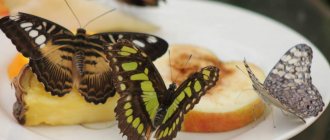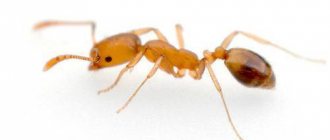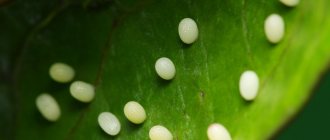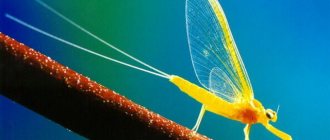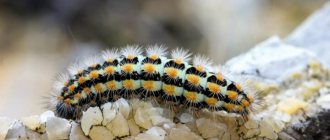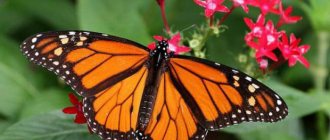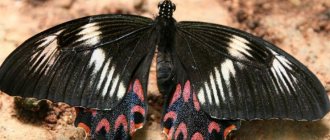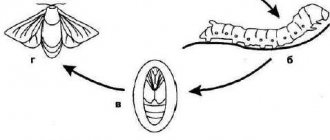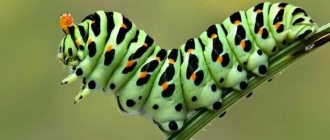Meet the butterfly!
Butterflies belong to the order of arthropods and, by the way, among invertebrates, they are the most highly developed creatures. There is probably no person who could look indifferently at a beautiful petal-like insect, which, moreover, has the amazing ability to undergo a complex metamorphosis, turning from a crawling insatiable caterpillar larva into an elegant winged creature.
It is interesting that back in the 19th century. caterpillars and butterflies were classified as different types of insects, but lepidopterology (the science of butterflies) helped put a lot of things into place. By the way, scientists are now confident that almost 100 thousand species of butterflies remain unstudied.
More about butterflies
This insect belongs to the species of arthropods; it is the most developed among invertebrates. There is hardly a person who would look indifferently at such a beautiful insect. She has a complex “life path”; she goes through a metamorphosis from a crawling caterpillar to a butterfly.
Back in the nineteenth century, scientists classified butterflies as various insects, but soon experts put everything in its place. Currently, more than 110,000 types of butterflies have not been studied.
Hives
Using hives as an example, this article will look at how many legs a butterfly has, and how they transform from a caterpillar.
Urticaria is most often found in the Russian Federation; it is a representative of the nymphalidae family.
Where can you find hives:
- North America;
- Asia;
- Europe;
- Japan;
- China.
Urticaria gets its name from its love of food in the form of nettles. In the fall, the male wren dies, and the females remain to spend the winter in various sheds, basements, crevices and other hidden areas. In winter, urticaria wraps its wings around its body like a blanket. Sometimes it freezes completely, becoming like a piece of ice.
Wrens are a small species of light-winged beauties that overwinter as adults. The butterfly comes out of hibernation early, this happens in April.
Urticaria - the harbinger of spring
Starting from the example of the well-known hives, we will find out what butterflies are, how many legs they have, and how their amazing transformations occur.
One of the most unique and at the same time frequently encountered representatives of the Nymphalidae family is the urticaria butterfly (Aglais urticae). It can be seen throughout North America, Europe, Russia, Asia, China and Japan. And it is named so in honor of its caterpillar’s addiction to one type of food - nettles.
Male urticaria die in the fall, and fertilized females overwinter in cracks, sheds, basements, attics and other secluded places, wrapping their body with wings like a blanket, and sometimes even freezing through and turning into a shard of ice.
These are one of the few butterflies that overwinter as an imago (adult). But already in April, with the first rays of the sun, urticaria emerge from hibernation and delight our eyes with bright black and orange spots against the background of the first greenery.
Unique wing structure
If you look at a butterfly, you can see a network of veins on the wings. In each family they form a specific pattern. The veins serve as mechanical support for the wing. They contain air and blood.
The entire wing, like a tile, is covered with tiny scales, which can vary in size. One wing can have up to 1 million scales.
The scales contain different pigments. Differently colored scales create a bright and unusual coloring of the wing. The caterpillars also store dyes when they feed on plants.
There are colorless flakes - these are optical flakes. They refract white light and create various light effects: silvery spots and stripes in mother-of-pearl pearls, azure-blue coloring of blueberries, metallic shine, green tints and others.
The scales not only give the butterfly different colors, but also facilitate its flight and protect it from the cold.
How butterflies feed and reproduce
Spring is the best time to see the structure of butterflies. You can learn everything about butterflies, or almost everything, by observing the urticaria and another early beauties - the lemongrass from the White butterfly family, which has bright lemon wings and got its name for this.
In early spring, they still have nothing special to profit from, and the butterflies are saved by sweet birch sap. And in the summer they, of course, prefer fruit juice, nectar of asters and daisies (urticaria) or hawthorn flowers (limongrass).
True, other beauties may have a special delicacy in animal excrement or wet clay, which, as it turned out, are a supplier of microelements necessary for insects. And the cutworms, which live in India and Malaysia, are completely predators. They feed on the blood and tear fluid of large animals.
In May, female wrens look for a suitable place for their eggs. And they find it, as you might guess, on young shoots of nettles, less often on hops or hemp. Cabbage butterflies prefer cabbage, and some types of butterflies scatter their eggs on the ground.
The female urticaria lays its yellow-green, barrel-shaped eggs in an uneven pile on the underside of the leaf, 150-200 pieces at a time and dies, and after ten to twelve days tiny caterpillars will appear from them.
Stages of development
The complex life cycle of a butterfly is surprising. It consists of 4 phases. The sequence is:
- Egg. Everything starts with him. Depending on the variety, the butterfly lays eggs on leaves, branches, and needles of various plants. The clutch can include up to 1 thousand eggs. The larva stays in the egg for 8 to 15 days.
- Caterpillar. The duration of this stage depends on the type and conditions of the environment and species. During this period of life, future butterflies have a worm-like shape with a gnawing type of mouth.
- Doll. The shape of the cocoon depends on the species and can be a circle, cylinder or oval. At this stage of development, the butterfly already has rudimentary wings, legs and a proboscis. She usually spends about 14 days in the cocoon.
- Butterfly. The lifespan of a butterfly can vary from several days to several months, depending on the species. At this stage, the insect is able to mate and lay eggs, which is the main task.
A lot of stories have been written about these amazing insects; they are fascinating due to the description of their beauty. There are also a number of interesting facts about butterflies:
- The size of the smallest known butterfly, called acetosia, is no more than 2 mm, and the largest, called agrippina, is 30 cm.
- Butterflies consume food like elephants - through the trunk, of course, the size of the trunk is very small, but there is definitely a similarity.
- About 165 thousand species of these beautiful creatures are known on the planet.
- The fastest and hardiest butterfly is called a swallowtail, at the moment it is very rare, but once this insect was seen in Tibet at an altitude of 4500 meters above the ground.
- But the most cunning are hawk moths; they have the ability to pretend to be a queen bee, creating a buzz. Using this trick, they enter the bee hive and gorge themselves on honey, which is their delicacy.
- Butterflies have taste buds on their legs, so they feed by sitting on top of the food.
- The habitat of butterflies includes such diverse places that only in the conditions of Antarctica these insects are not able to survive. Despite their fragile structure, they can withstand even the harsh climate conditions of Queen Elizabeth Island, which is located just a thousand kilometers from the North Pole.
- During their very short life, butterflies lay up to a thousand eggs, from which caterpillars will soon hatch.
- The Apollo butterfly is the only one that can live where there is snow all year round and not experience discomfort.
- Almost all butterflies are afraid of water, as it has a detrimental effect on the condition of insect wings, and only one butterfly, called the lilac moth, is able to emerge from the water and continue flying.
- Some species of butterflies can reach speeds of up to 60 kilometers per hour.
- The monarch butterfly is a true healer among its species. She is able to recognize the beneficial properties of plants and successfully use them if her fellow creature needs help.
- Calyptra eustrigata is a very rare species of butterfly, but no less interesting. The males of this species are capable of drinking blood, like mosquitoes.
- Moths have an exoskeleton that is located on the outside of their body.
- The complex structure of the eyes makes it possible to recognize certain colors.
Lepidopterologists study butterflies; there is an entire section in entomology dedicated to these beautiful creatures.
What do hives caterpillars look like?
Immediately after hatching, the larvae eat the empty eggshell and entwine the lower part of the leaf with a common web-net, under which they hide at night and in bad weather, and if the sun is shining, the caterpillars eat greedily.
The larvae live closely together, do not spread far from each other, and sometimes eat up their “home” - nettles - so that only the veins remain of the leaves.
Studded with spiny-like outgrowths with short hairs, the bodies of insatiable urticaria caterpillars, as a rule, have a brown, almost black color with double yellow longitudinal stripes. By the way, during their development, they, like the larvae of other butterflies, molt several times, changing their shell and thus increasing in size by almost 2 cm per month.
And before we find out how many legs a butterfly has, let's count them on the larva. Like most caterpillars, the urticaria has five pairs of abdominal legs (called false), as well as three pairs of thoracic legs - true ones. Of these, later, during pupation, the butterfly will develop its six legs, but the false legs are rather a device for holding the larva on the leaf. They are usually plump and short, adorned at the end with tiny hooks and hooks that act like Velcro.
How many legs does a butterfly caterpillar have?
The body of caterpillars consists of a head, three thoracic and ten abdominal segments. They have three pairs of legs in the thoracic region. Which corresponds to the number of legs in an adult and at the same time this is the only similar feature. In addition to them, there are several more pairs of pseudopods on the caterpillar’s body: from two to five. They are designed to make it more convenient for the larva to move and stay on the leaves and stems of plants.
The caterpillar grows quickly because it eats more than its own weight. The size of the body increases, and they need to get rid of tight coverings. Therefore, she needs to shed periodically.
From chrysalis to butterfly
Before pupation, the caterpillars become more aloof and stop their endless feeding process to look for a safe place to latch onto. As a rule, this happens right there, on the food plant, but sometimes the caterpillars crawl 15 m to find a suitable place for themselves. This could be a fence, wall or other vertical surface.
On it the caterpillar hangs upside down, secured with its glue, and when the skin slides off the larva, in its place there appears a pupa, which has an angular shape and is painted brown or golden, sometimes with a beautiful pearlescent sheen.
After about three weeks, such a pupa will hatch into a butterfly with very short wings. She will sit for a while, growing them (they get bigger just before our eyes!), and then take off on her first flight.
Butterfly structure
U
Butterflies have two pairs of wings - this is where the beauty of these fragile creatures lies. Butterflies have both pairs of wings for flight; There are no elytra, characteristic of beetles and Orthoptera. By nature, the wing is two-layered and is formed by the upper and lower lateral folds of the body.
The wings are dissected by longitudinal and transverse veins, tube-shaped extensions of the wing plate. The veins perform a dual function: firstly, a frame function, and secondly, trachea and nerve fibers pass through the cavity of the tubes.
Based on the shape of the wings and the arrangement of the veins, species recognition and differentiation mainly occur.
The figure shows a diagram of the wing venation: Sc - subcostal vein, R - radial, M - medial, Cu - cubital, A - anal veins.
The wings are covered with scales that form pollen on their surface - this is not found in any other representatives of the animal world. These are modified hairs found on the wings of many insects. The number of scales can be very large - several hundred thousand in some species!
The shape and purpose of the scales are different. First of all, there are pigment and optical scales that determine the color of the wings. The former contain the coloring substance melanin and are responsible for the main color. And the latter, passing rays of light through their own structure, refract them, causing interference phenomena (based on the principle of a prism). This is why, at different lighting angles, butterfly wings take on new colors and shades. Thanks to this, the wings of butterflies become metallic-shiny and iridescent - they are especially beautiful in tropical butterflies.
The scales arranged on a butterfly's wing, like tiles on the roof of a house, are often brightly colored and form lines, spots, stripes, stains - everything that is called a “wing pattern” (see diagram below). The number and arrangement of pattern details are different even among closely related species. Eyes, holes, spots and bands can change their location, move to unusual places or simply disappear. This is how butterflies are mainly identified - after all, the design of each butterfly is unique.
The coloring of the wings of male and female butterflies is often completely different. Biologists call this phenomenon sexual dimorphism in color. Moreover, it is rare, but there are individuals that combine the wings of both sexes: on the left - with the colors of the male, on the right - the female, or vice versa. Such genetically distorted specimens are called “gynandromorphs.”
The odorous, or androconial, scales are amazing. To make the molecules of the fragrant substance evaporate more easily from the surface of the wing, the tips of these scales end in a brush of hairs. During marriage ceremonies, some butterflies, when meeting, look for odorous scales with their antennae and choose their partner by their aroma. And distance is not a barrier: males find mates by smell several kilometers away! Sometimes the smell of a butterfly is so strong that a person can smell it.
Every rule in nature has exceptions. There are species in which scales remain only along the edges of the wings and along the veins. Such butterflies include, for example, glassworts and bumblebee hawk moths. Their abdomen is painted with bright black and yellow stripes and, in combination with transparent narrow wings, makes these insects look like wasps or bumblebees.
Finally, there are butterflies that are completely devoid of the ability to fly. Thus, the females of the skinned moth, one-colored and snail-shaped bagworms, brushtails, and some cocoon moths are wingless. They look very little like butterflies, more like worms. Therefore, the meeting of the sexes in these species is ensured by winged males.
What does a butterfly look like?
What is the external structure of a butterfly? It can be roughly divided into three parts: head, chest and abdomen. On the head of the butterfly there are large eyes and a pair of long antennae, which extend from the frontal part between the eyes of the insect and help it perceive odors, air vibrations, and also maintain balance in flight.
On the lower part of the head, the butterfly has an oral apparatus in the form of a proboscis twisted into a spiral, formed by connected but not fused lobes of the lower jaw (they, by the way, are easily separated with a pin).
Through this proboscis, the butterfly, using a pharyngeal pump similar to a blacksmith's bellow, draws in nectar.
Butterfly structureButterflies are arthropods - the most highly developed animals among invertebrates. They got their name from the presence of articulated tubular limbs. Another characteristic feature is the exoskeleton, formed by plates of a durable polysaccharide - quinine. In arthropods, due to the development of a durable outer shell and articulated limbs, a complex system of muscles appeared, attached from the inside to the integument. All movements of their body parts and internal organs are associated with muscles.
1 - abdomen 2 - chest 3 - head with antennae 4 - proboscis 5, 8, 9 - front, middle and hind legs 6, 7 - first and second pair of wings
Body of butterflies
consists of three sections: head, chest and abdomen. With a webbed, short and soft neck, the head is attached to the chest, which consists of three segments motionlessly connected to each other. The connection points are not noticeable. Each of the segments bears a pair of jointed legs. Butterflies have three pairs of legs on their chest. The forelegs of male nymphalids and satyr pigeons are underdeveloped; in females they are more developed, but when walking they are also not used and are always pressed to the chest. In swallowtails and fatheads, all legs are normally developed, and the tibiae of their front legs are equipped with lobe-like structures, which are believed to be used for cleaning the eyes and antennae. In butterflies, legs serve mainly to secure themselves in a certain place and only then for movement. Some butterflies have taste buds on their legs: before such a butterfly touches the sweet solution with its limb, it does not open its proboscis and does not start eating.
The head contains mouthparts, antennae and eyes. The oral apparatus of the sucking type is a non-segmented, spirally curled, long tubular proboscis at rest. The lower jaw and lower lip take part in its formation. Butterflies have no upper jaws. While eating, the butterfly straightens its long proboscis, plunging it deep into the flower, and sucks out the nectar. Adult lepidoptera use nectar as the main source of food, and therefore are among the main pollinators of flowering plants. All insects, including butterflies, have a special organ called the Jones organ, designed to analyze shaking and sound vibrations. With the help of this organ, insects not only assess the state of the physical environment, but also communicate with each other.
- Vision
- Antennae or antennae
- Wings and their coloring
- Butterfly wing cleaning system
- Fly of butterfly
Internal structure
Butterflies have a perfect nervous system and sensory organs
, thanks to which they are well oriented in their surroundings and quickly respond to danger signals. The nervous system, like that of all arthropods, consists of a peripharyngeal ring and a ventral nerve cord. In the head, as a result of the fusion of clusters of nerve cells, the brain is formed. This system controls all movements of the butterfly, except for such involuntary functions as blood circulation, digestion, and breathing. Researchers believe that these functions are controlled by the sympathetic nervous system.
1- excretory organs 2- mid-intestine 3- goiter 4- heart 5- foregut 6- large intestine 7- genitals 8- nerve ganglion 9- brain
Circulatory system
, like all arthropods, not closed. Blood directly washes the internal organs and tissues while in the body cavity, transferring nutrients to them and carrying harmful waste products to the excretory organs. It does not participate in the transfer of oxygen and carbon dioxide, that is, in respiration. Its movement is ensured by the work of the heart - a longitudinal muscular tube located in the dorsal part above the intestines. The heart, pulsating rhythmically, drives blood to the head end of the body. The backflow of blood is prevented by the heart valves. When the heart expands, blood enters it from the back of the body through its side openings, which are equipped with valves that prevent blood from flowing back. In the body cavity, unlike the heart, blood flows from the front end to the back, and then, entering the heart as a result of its pulsation, it is again directed to the head.
Respiratory system
It is a dense network of branched internal tubes - tracheas, through which air, entering through the external spiracles, is delivered directly to all internal organs and tissues.
Excretory system
- this is a bundle of thin tubes, the so-called Malpighian vessels, located in the body cavity.
They are closed at the tops, and open at the bases into the intestines. Metabolic products are filtered out by the entire surface of the Malpighian vessels, and then inside the vessels they turn into crystals. Then they enter the intestinal cavity and, together with undigested food debris, are excreted from the body. Some harmful substances, especially poisons, accumulate and are isolated in the fat body. reproductive system
consists of two ovaries, in which eggs are formed. The ovaries, passing into tubular oviducts, merge at their bases into a single unpaired oviduct, through which mature eggs are released. In the female reproductive system there is a spermatheca - a reservoir into which male sperm enter. Mature eggs can be fertilized by these sperm. The reproductive organs of the male are two testes that pass into the vas deferens, which unite into an unpaired ejaculatory duct, which serves to excrete sperm.
- Why are butterflies so beautiful?
What are the legs of a butterfly hives for?
And how many walking legs a urticaria butterfly has can be determined by carefully examining it.
The butterfly's chest is divided into three segments, each of which carries its own pair of legs. Butterflies have six of them in total. But the anterior pair in some species are vestigial processes.
Such butterflies use only four legs as walking legs. True, it should be noted that in all of them they serve to a greater extent only for fastening to the surface, and not for walking, so they are equipped with a large number of special devices. And many butterflies also have taste buds on their legs. And the insect will not start eating until it touches the sweet nectar with its limbs.
Types of representatives
Science knows about 158 thousand representatives of various species of butterflies. Only runaways, this is one of the subspecies, is divided into several types, differing in appearance by a number of other features:
- Cabbage butterfly. A butterfly, the males of which are white with black dots, the females are bright yellow. The size is about 65 mm. They feed on plants.
- Lemongrass. The representative of this species is yellow in color, and the female is white-green. They are united by a red circle located in the center. The wings are made in a very unusual way, with imitation ends cut off with scissors. Its size is about 55 mm.
- White pea. An endangered species of the family. The outer sides of the wings are colored white and gray, while the inner sides are green, allowing her to blend in with the grass.
- Turnip white. It is similar to the cabbage butterfly, but differs in size, which is about 45 mm, and in the number of black spots on the wings. The male has 1 spot, and the female has 2.
- Greenfinch. It has a white color with dark spots and a green pattern; it feeds on cruciferous vegetables, in which it lays its eggs.
- White rapeseed. It is white in color with a yellow pattern and clearly visible veins. Is migratory. For the winter it flies to warmer climes, namely North Africa.
- Alpine whiteweed. It has a white-gray color. In males, the ends of the wings are painted black with white splashes.
- White euphema. It is white with a yellow tint and has a dark spot in the center. The lower wings are decorated with a green pattern. It is a steppe inhabitant.
- Hawthorn. The butterfly is white with clearly visible black veins. Its size is about 60 mm.
Cocoonworm family
Insects belonging to this family are large or medium in size with a large body that is covered with hairs. They are more like moths, their antennae have bristles, and their front wings are much larger than their hind wings. The main representatives include:
- The Siberian is medium in size, yellow-brown in color with a white spot in the center, but the color of the wings can vary from individual to individual and can be black. Uses tree needles for food and egg laying.
- Ringed. The size is about 40 mm. It has a yellow-brown color on the front wings with two dark stripes. The hind wings are a lighter color without stripes. It lays its eggs in the form of a ring, which is how it got its name. It is a tree pest.
- Pine. The butterfly is large (about 80 mm) with a color that resembles pine bark. Flies in the second half of July. Lives in pine forests.
They usually live in groups in trees. Some members of this family are pests.
Blueberry family
Five thousand species of this family are known in nature, some of which are on the verge of extinction and are listed in the Red Book. They are medium in size and bright in color, but depending on the species, the color may vary. A distinctive feature of bluebirds is the colored pattern on the lower wings in the form of eyes. They are not pests; on the contrary, they are beneficial in the form of repelling insect pests.
Bright pieds
Includes about 1,200 species, most of which live in the tropics. They range in size from medium to large and are brightly colored with a rainbow pattern. It is needed to warn that the insect is poisonous, and if life is threatened, it will defend itself by secreting a poisonous liquid that has a pungent odor. Among the main representatives are :
- Admiral. It has an average size of about 55 mm with a velvety surface and a bright color of white spots with a red stripe.
- Peacock eye. A large butterfly, up to 150 mm in size, with a bright red-brown color with an eye pattern at the corners of the wings. This pattern protects the insect by scaring away enemies.
- Swallowtail. An endangered species of butterfly. A multi-colored species of insects, with tails on the lower wings, the most attractive are swallowtails with a yellow color and black spots and veins.
It prefers the leaves of legumes as food, which is a distinctive characteristic.
What do the legs of a hives look like?
The legs of the wren, like those of other butterflies, are called running legs. They are classified as such due to their structural features. They, like other species of butterflies, are segmented and are divided into five segments, which are called the coxa, trochanter, femur, tibia and tarsus. The paws are divided into five more segments and have a pair of claws at the end.
Almost all butterflies have spurs on the front legs (the so-called pineal gland), which the insect uses to clean the antennae. True, for example, it is difficult to answer how many legs the bagworm butterfly has, since its legs are reduced almost completely.
Organs of smell and touch
The antennae serve as the organs of smell for butterflies. The larger the antennae, the better for the butterfly. Sensitive cells of the sensilla are located on the antennae. For example, moths have more than 100 thousand of them.
Olfactory sensilla are present on the labial palps and on the hind legs. The butterfly tastes the food with its feet. If a butterfly gets its hind leg into a sugar solution, it will immediately open its proboscis and begin sucking the sweet liquid.
With the help of antennae, moths detect the smell of opened flowers and individuals of the opposite sex. Scientists have found that males can sense females at a distance of 16 kilometers.
Most butterflies use their antennae to detect sound waves and mechanical shocks.
Sensitive hairs are located throughout the butterfly's body. They are connected to nerve endings that transmit signals to the brain. Therefore, any touch to its body is quickly registered in the brain, and the butterfly instantly feels pain.
How are the legs of butterflies arranged?
How many legs a butterfly has and what function they perform directly affects their structure.
- The first segment of the leg, the coxa, is almost motionlessly attached to the butterfly’s abdomen, on the inside of which a number of muscles are attached that allow the leg to extend, bend and give its movement a certain amplitude.
- Between the coxa and the thigh there is the next segment - the trochanter. This is the smallest part of the foot, which ensures its mobility. The role of the trochanter can be compared to that of the hip joint in humans.
- The longest part of the leg that bears the main load is the thigh. It is the size of the hip that determines what type of legs a particular limb of an insect is classified as. The thigh is connected to the trochanter motionlessly, but to the lower leg - with the help of a mobile joint. It's called the knee.
- The butterfly's shin is almost the same length as the thigh, but its volume is smaller.
- The tarsus is the last segment of the limb of the urticaria. It consists of five parts and has a pair of claws at the end.
Between caterpillar and butterfly: pupa
After 4-5 molts, the caterpillar turns into a motionless pupa covered with chitin. Some pupae look like a butterfly mummy - folded legs, antennae pressed to the body. There are also those that do not resemble either a caterpillar or a butterfly: the body is covered with spines and outgrowths.
After the onset of the pupal stage, the insect undergoes continuous metamorphosis. During this time they do not move or eat. Ultimately, the chitinous cover of the pupa bursts and a butterfly emerges from it.
The pupa is the defenseless life period of an insect. If danger arises, she will not be able to hide. Therefore, before pupating, it is important for the caterpillars to take care of a safe place for transformation, and their legs help them a lot in this.

